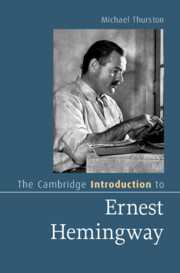Book contents
- The Cambridge Introduction to Ernest Hemingway
- The Cambridge Introduction to Ernest Hemingway
- Copyright page
- Dedication
- Contents
- Acknowledgments
- Introduction
- Chapter 1 Life
- Chapter 2 Contexts
- Chapter 3 Crafting a Style
- Chapter 4 Consolidating a Career
- Chapter 5 Men and Beasts
- Chapter 6 Men (and Women) at War
- Chapter 7 Last and Posthumous Works
- Chapter 8 Reception
- Works Cited
- Index
Chapter 8 - Reception
Published online by Cambridge University Press: 15 September 2025
- The Cambridge Introduction to Ernest Hemingway
- The Cambridge Introduction to Ernest Hemingway
- Copyright page
- Dedication
- Contents
- Acknowledgments
- Introduction
- Chapter 1 Life
- Chapter 2 Contexts
- Chapter 3 Crafting a Style
- Chapter 4 Consolidating a Career
- Chapter 5 Men and Beasts
- Chapter 6 Men (and Women) at War
- Chapter 7 Last and Posthumous Works
- Chapter 8 Reception
- Works Cited
- Index
Summary
Hemingway’s work was well received from the moment he began to publish. Some of the key ways in which his work has been read were established from the beginning, as critics identified the core elements of Hemingway’s emergent style and as they responded to his resonant themes. Later generations of academic critics, however, brought to bear on Hemingway’s stories and novels the shifting frameworks that would emerge, become dominant, and linger residually in the institutions of literary studies. Chief among the frameworks that would enrich the reading of Hemingway’s work in subsequent decades were the attention to matters of gender and sexuality made legible by feminism and queer theory in the 1980s and 1990s and the attention to race as inextricable from the construction and focalization of Hemingway’s narratives in the 1990s and 2000s. Most recently, the rise of postcolonial studies, ecocriticism, and critical disability studies has enabled fresh readings of the work, readings that keep it alive in current cultural debates. Throughout these changes, attention to Hemingway’s achievements in narrative form continues to be important, and it is as a crafter of sentences, and of narratives from carefully constructed sentences, that Hemingway continues to influence fiction writers.
Information
- Type
- Chapter
- Information
- The Cambridge Introduction to Ernest Hemingway , pp. 169 - 190Publisher: Cambridge University PressPrint publication year: 2025
Accessibility standard: WCAG 2.2 AAA
Why this information is here
This section outlines the accessibility features of this content - including support for screen readers, full keyboard navigation and high-contrast display options. This may not be relevant for you.Accessibility Information
Content Navigation
Allows you to navigate directly to chapters, sections, or non‐text items through a linked table of contents, reducing the need for extensive scrolling.
Provides an interactive index, letting you go straight to where a term or subject appears in the text without manual searching.
Reading Order & Textual Equivalents
You will encounter all content (including footnotes, captions, etc.) in a clear, sequential flow, making it easier to follow with assistive tools like screen readers.
Visual Accessibility
You will still understand key ideas or prompts without relying solely on colour, which is especially helpful if you have colour vision deficiencies.
You benefit from high‐contrast text, which improves legibility if you have low vision or if you are reading in less‐than‐ideal lighting conditions.
